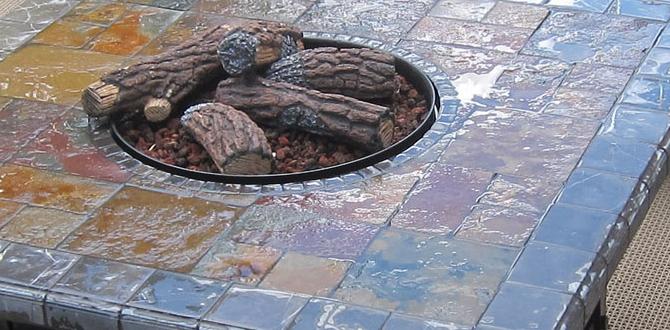Quick Summary
Discover the best indoor party games for 10-year-olds that guarantee essential, unforgettable fun. This guide offers easy-to-set-up, engaging activities perfect for any birthday or rainy day, ensuring a celebration packed with laughter and excitement for the birthday child and their friends.
Planning a party for a 10-year-old can be a bit tricky. You want to keep a group of energetic kids entertained, happy, and under control, all while staying indoors. It’s easy to feel a little overwhelmed trying to find games that are just right for this age – not too babyish, but not too complicated either. Don’t worry! We’ve got you covered with a fantastic selection of indoor party games that are simple to prepare and guaranteed to bring on the giggles and good times. Get ready to turn any indoor space into a hub of exciting activities!
Why Indoor Party Games Matter for 10-Year-Olds
At 10 years old, children are in a fascinating stage of development. They’re more independent, enjoy challenges, and thrive on social interaction. Indoor party games are crucial because they provide a structured yet fun way for them to connect, compete (friendly, of course!), and burn off some of that boundless energy, especially when the weather outside isn’t cooperating. These games help foster teamwork, creativity, and problem-solving skills, all while creating lasting memories. A well-chosen game can be the highlight of the party, leaving everyone with smiles and stories to share.
Top Indoor Party Games for 10-Year-Olds: Loads of Laughter Guaranteed!
Finding the perfect mix of active and creative games is key to a successful indoor party. For 10-year-olds, games that involve a bit of strategy, teamwork, and maybe a touch of silliness tend to be big hits. We’ve rounded up some of the best options that require minimal fuss and maximum fun.
1. Charades or Pictionary – The Classics That Never Get Old
These drawing and acting games are fantastic for getting imaginations working and for lots of laughs. They are perfect for mixed groups and highly adaptable. You can even tailor the themes to your child’s interests!
How to Play Charades:
- Divide the guests into two teams.
- Prepare slips of paper with words or phrases. These could be movie titles, book names, animals, actions, or well-known people. For 10-year-olds, tailor them to popular characters from shows or games they enjoy.
- One player from a team draws a slip and has to silently act out the word or phrase for their team. They have a set amount of time (e.g., 1-2 minutes).
- Their team shouts out guesses. If the team guesses correctly within the time limit, they get a point.
- Teams take turns. The team with the most points at the end wins.
How to Play Pictionary:
- Similar to Charades, divide players into teams for competitive play, or play cooperatively where one person draws for the whole group to guess.
- Write down words or phrases on slips of paper.
- One player draws a word and begins to draw it on a whiteboard or large paper without speaking or using letters/numbers.
- Their team guesses what they are drawing. The first team (or group) to guess correctly wins a point.
- The drawer can pick a new word as soon as their team guesses correctly, trying to get as many points as possible in a set time.
Pro-Tip: For Pictionary, use a freestanding easel or a large roll of paper taped to a wall. For Charades, ensure there’s enough space for acting!
2. The Human Knot – A Fun, Wrinkly Puzzle
This game is a brilliant way to encourage communication and problem-solving in a physical, yet confined, space. It’s always a hilarious sight to see the kids untangle themselves!
How to Play:
- Have everyone stand in a tight circle.
- Instruct everyone to reach across the circle with their right hand and grab the hand of someone who is NOT directly next to them. Then, do the same with their left hand, grabbing a DIFFERENT person’s hand.
- The goal is for the group to untangle themselves without letting go of hands, forming a single circle again.
- Encourage them to talk to each other and strategize.
Variations: You can play this with smaller groups if needed, or set a time limit for an extra challenge.
3. Indoor Scavenger Hunt – Adventure in Your Own Home
A scavenger hunt turns your home into a treasure island! It’s excellent for stimulating minds and encouraging teamwork. You can make it as simple or as complex as you like.
Setting Up Your Scavenger Hunt:
- Choose a Theme (Optional): Pirates, spies, detectives, or even a favorite book or movie theme can add an extra layer of excitement.
- Create Clues: Write a series of clues that lead from one location to the next. The clues can be riddles, puzzles, or simple directions. For 10-year-olds, riddles are often the most engaging.
- Hide the Clues: Place the first clue somewhere obvious or give it to the birthday child to start. Each clue should lead to the next hiding spot. The final clue should lead to a prize or the next party activity.
- The Prize: This could be a box of party favors, a birthday cake, or even just bragging rights.
Example Clues for 10-Year-Olds:
- “I have a screen but no eyes, I show you worlds and tales of surprise. Where can you find me sitting day and night? Look near me for your next clue, shining bright.” (Answer: Television/Computer)
- “I’m full of stories, both old and new, with pages to flip and knowledge for you. Find me on a shelf, standing tall. Your next clue is hidden within my call.” (Answer: Bookshelf)
- “Keeps your food cold and your drinks so chill, open my door, and your clue you will find, if you have the will.” (Answer: Refrigerator)
External Resource: For more creative clue ideas, check out The Spruce Crafts’ guide to scavenger hunt clues.
4. Minute to Win It Challenges – Quick, Creative Fun
Inspired by the TV show, these challenges are short, quirky, and hilarious. They are perfect for keeping everyone engaged and provide tons of opportunities for photos and funny moments.
What You’ll Need (Examples):
- Cups
- Balloons
- Cotton Balls
- Straws
- Small Objects (e.g., buttons, coins, dried beans)
- Bowls
- Paper Plates
Sample Challenges:
1. Balloon Keep-Up: Keep a balloon from touching the floor using only your hands. You can use two balloons for added difficulty.
2. Stack Attack: Stack 10 cups into a pyramid shape and then unstack them back into a single pile, all within 60 seconds.
3. Cotton Ball Scoop: Using only a straw, suck up as many cotton balls as possible from a bowl and transfer them to another bowl in one minute.
4. Cookie Face: Place a cookie on a child’s forehead. They must move it into their mouth using only facial muscles. No using hands allowed!
5. Penny Tower: Stack as many pennies as possible one on top of another in 60 seconds.
Scoring: You can award points for each successful challenge. The child who completes the most challenges or gets the highest score wins.
5. DIY Obstacle Course – Active Play, Indoors!
Transform your living room or a larger indoor space into an exciting obstacle course. This is a fantastic way to get kids moving and competing against the clock or each other.
Setting Up an Obstacle Course:
- Plan the Course: Think about different types of movements: crawling, jumping, balancing, throwing.
- Gather Materials: Use items you already have at home.
- Set Up Stations: Create distinct challenges at different points.
Obstacle Course Ideas:
- Crawl through a tunnel: Use blankets draped over chairs or furniture, or purchase a pop-up play tunnel.
- Jump onto cushions: Arrange cushions or pillows on the floor for kids to hop across.
- Balance beam: Lay a strip of masking tape on the floor for kids to walk along, or use a low, wide piece of wood if available and safe.
- Ball toss: Have them throw soft balls into a laundry basket or bucket from a short distance.
- “Laser” maze: String red yarn or crepe paper across a hallway at different heights to create an intricate maze they must navigate without touching.
- Hula hoop challenge: Hula hoop in place for a set number of seconds.
- Beanbag or soft toy toss: Toss beanbags or soft toys through a hoop or into buckets.
- Clear an area for dancing.
- Play some upbeat music.
- When the music stops, everyone must freeze in their current position.
- Anyone caught moving is out for that round.
- The last person standing (or the one who can freeze the most creatively) wins the round.
- Each guest takes a turn stating three “facts” about themselves.
- Two of these “facts” must be true.
- One “fact” must be a lie.
- The other guests then try to guess which statement is the lie.
- The person reveals the lie after everyone has guessed.
Safety First: Ensure the area is clear of tripping hazards and that all props are safe and age-appropriate. Supervise closely.
6. Musical Statues/Freeze Dance – Classic Energy Burner
This is a simple, high-energy game that’s always a hit. It’s perfect for getting wiggles out and requires very little preparation.
How to Play:
Tip: Use a variety of music genres to keep it interesting!
7. Two Truths and a Lie – Getting to Know Each Other
This game is great for a slightly calmer moment and helps kids learn more about each other in a fun, engaging way. It’s also a good icebreaker if not all the guests know each other well.
How to Play:
Example:
“I have two cats.”
“I’ve been to Disneyland.”
* “I can speak French.”
(The lie could be any of them, depending on what’s true for that child.)
Games Table: Pros and Cons for Indoor Parties
Choosing the right games involves balancing different factors. Here’s a quick look at the advantages and disadvantages of some popular indoor party games for 10-year-olds.
| Game | Pros | Cons |
|---|---|---|
| Charades/Pictionary | Encourages creativity, teamwork, adaptable themes, minimal props needed. | Some children can be shy acting or drawing, requires clear instructions. |
| Human Knot | Promotes communication, problem-solving, active and engaging, no props needed. | Can get a bit too close for comfort for some, potential for minor bumps if not supervised. |
| Scavenger Hunt | Exciting, encourages exploration, adaptable to space and theme, promotes reading/comprehension. | Requires significant setup time, clues need to be well-chosen, prize might be hard to manage. |
| Minute to Win It | Fast-paced, lots of variety, hilarious to watch, requires common household items. | Can be competitive, requires careful timing and supervision, some challenges might be tricky for certain children. |
| Obstacle Course | Excellent for burning energy, promotes physical activity, adaptable to space and materials. | Requires ample space, potential safety hazards if not set up properly, some items might need purchasing. |
| Musical Statues/Freeze Dance | Simple to understand and play, great for energy release, no props needed. | Can be very loud, requires space, not much strategic element. |
| Two Truths and a Lie | Encourages listening, improves social skills, good for ice-breaking, calm activity. | Requires a bit of thought from each child, might be slow for very energetic groups. |
Tips for Running Smooth Indoor Party Games
Even the best games can fall flat if not managed well. Here are some tips to ensure your party games run like a well-oiled machine, filled with fun and minimal meltdowns.
Preparation is Key
Before the party, set aside time to plan. Gather all necessary materials for your chosen games. If you’re doing a scavenger hunt, write and hide the clues. If it’s a Minute to Win It challenge, measure out the materials needed for each station. Having everything ready beforehand will save you stress on the day.
Clear Instructions
Keep it Simple: Explain the rules clearly and concisely. For 10-year-olds, a quick demonstration is often more effective than a long verbal explanation. Demonstrate each game or challenge once.
Check for Understanding: Ask the kids to repeat the rules back to you or ask clarifying questions like “So, what do we do first?”
Manage the Energy Levels
Balance Active and Calm: Alternate between high-energy games and quieter activities. After a round of Freeze Dance, a calm game like “Two Truths and a Lie” or a craft can be a great way to re-regulate.
Take Breaks: Don’t feel pressured to have back-to-back games. Allow for natural breaks for snacks, drinks, or just free play.
Inclusivity and Fairness
Adapt for All: Be prepared to adapt games slightly if a child has a specific need or is struggling. The goal is fun for everyone.
Fair Play: Emphasize good sportsmanship. Remind the children that it’s okay to lose, and it’s important to be kind to others.
Prize Management
Focus on Fun, Not Just Winning: While small prizes can be motivating, ensure that the emphasis is on participation and enjoyment. You can award small prizes to winners, but also consider participation prizes or a ‘most creative’ award.
Consider Group Prizes: For team games, a prize for the winning team can be a good motivator, or even a treat for everyone at the end of a successful game.
Backup Plan
Always have an extra game or two up your sleeve in case one doesn’t go as planned or the kids finish faster than expected. A simple card game or a quick scavenger hunt can save the day.
FAQ: Your Indoor Party Game Questions Answered
Q1: What are the best types of games for a 10-year-old’s indoor party?
The best games for 10-year-olds are those that are engaging, slightly challenging, and encourage interaction. Consider a mix of active games (like an obstacle course or freeze dance), creative games (like charades or Pictionary), and problem-solving games (like a scavenger hunt or human knot). These ensure a variety of fun for different personalities.
Q2: How much space do I need for indoor party games?
The space requirement varies. Active games like obstacle courses or freeze dance need a clear, open area. Games like charades or human knot can be managed in a medium-sized room. For quieter games like ‘Two Truths and a Lie’ or Pictionary, you might only need a table and chairs. Always ensure there’s enough room for children to move safely without bumping into furniture or each other.
Q3: What if some kids are shy and don’t want to participate?
It’s common for some children to be hesitant. Start with less pressure games, like team-based activities where they contribute without being the sole focus. For individual performances, offer praise and encouragement, and let them know it’s okay to sit out a round. Sometimes, seeing others have fun will draw them in naturally. You can also adapt games for smaller groups or




